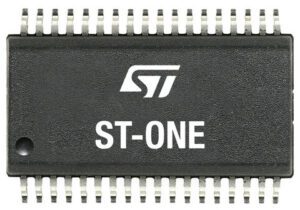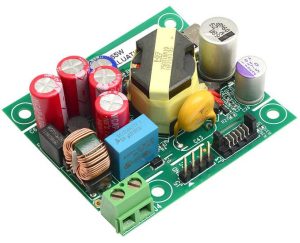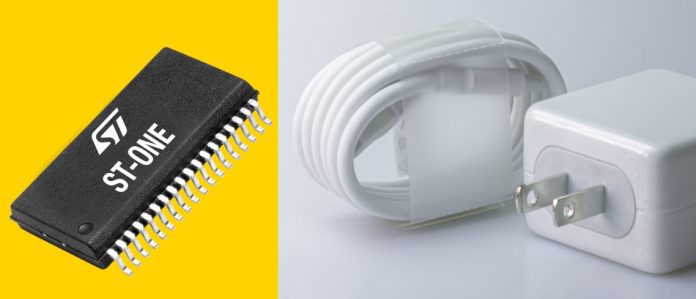The ST-ONE is the world’s first digital controller to house an Arm Cortex-M0+ core, an active clamp flyback controller, and a USB Power Delivery 3.1 module within the same package. Combined with our MASTERGAN power stages, ST-ONE enables small chargers with a power density of 30 W/in3. Comparatively, current models only offer a third of that. Our recent demonstrations showcase a unit that looks and feels like a smartphone charger but can power a laptop. Moreover, we offer a development board to ensure partners can design their products rapidly. Hence, we expect the first products using ST-ONE to be commercially available by the end of the year or early 2023.
What does the quest for greater power density look like?
More power in the same form factor
The advent of GaN devices came with the promise of far greater energy efficiency. Technically, it can mean two things: chargers get smaller while delivering the same power or provide more power out of the same form factor. Wall chargers are unique because they already have gotten nearly as small as they can. Manufacturers must use prongs that fit into the wall socket and respect international standards such as the creepage distance, which sets the minimum space between two insulators. Such considerations, therefore, limit how small a wall charger can get. Consequently, as engineers look to provide more power within the same form factor, GaN appears like a fantastic solution.
GaN power devices and new ICs
Gallium Nitride has a wide bandage, making it a much more efficient power device at high voltage. Its higher breakdown voltage and low on-state resistance primarily mean that it can support far greater loads within a smaller device than a silicon alternative. However, driving GaN power devices requires more complexity to maximize the benefits of their high switching frequency. For instance, circuits must have a stable supply voltage and avoid spurious gate noises at all costs. After witnessing some of the issues engineers face, we wrote an application note to offer the best tips for driving E-mode GaN devices. The ST-ONE represents another solution to this problem by providing a unique all-in-one solution.
What’s inside the ST-ONE?
Primary side
 ST-ONE comprises two major parts: a primary and a secondary side controller. The former uses a high-voltage start-up generator that directly connects to the mains and can handle spikes of up to 800 V. It thus saves teams from adding an external sensing circuit. Designers need a couple of diodes for the AC input voltage, and the ST-ONE does the rest. We even include an X capacitor (X-Cap) discharge circuit, which is often mandated by safety regulations. Additionally, the primary side includes the active clamp flyback that is essential for driving a GaN power device. The controller operates at up to 1 MHz and supports a low quiescent current for no-load consumption.
ST-ONE comprises two major parts: a primary and a secondary side controller. The former uses a high-voltage start-up generator that directly connects to the mains and can handle spikes of up to 800 V. It thus saves teams from adding an external sensing circuit. Designers need a couple of diodes for the AC input voltage, and the ST-ONE does the rest. We even include an X capacitor (X-Cap) discharge circuit, which is often mandated by safety regulations. Additionally, the primary side includes the active clamp flyback that is essential for driving a GaN power device. The controller operates at up to 1 MHz and supports a low quiescent current for no-load consumption.
Secondary side
On the secondary side, ST-ONE includes a synchronous rectifier instead of a more traditional diode to improve energy efficiency. Similarly, it includes a 24 V N-channel load switch gate drive, so engineers don’t have to add numerous external components to disconnect the output voltage when using a dual-role USB-C port. Moreover, the ST-ONE reflects our work on our USB-C PD ecosystem since it includes a complex power delivery controller capable of supporting proprietary interfaces. The presence of a Type-C PHY controller also simplifies design operations. Evidently, the secondary side oozes optimizations to ensure greater efficiency, a shorter market time, and a lower bill of materials.
Innovations
Out of all the components on the secondary side, the custom Cortex-M0+ core is undoubtedly one of the features that explains what made ST-ONE possible today. Indeed, using a traditional STM32 would have been too costly and too big. However, strengthened by our expertise in microarchitectures and USB-PD systems, we designed a custom device that made such an integrated solution viable.
The microcontroller includes 64 KB of flash, 8 KB of RAM, and a 12-bit analog-to-digital converter to control both the AC/DC stage and the USB-PD protocol, thus handling the fast switching requirements of GaN devices. We also included a finite-state machine that optimizes computations. As a result, we can make a smaller die with fewer transistors while retaining optimal performance.
Another innovation that made the ST-ONE possible was the galvanic isolation between the primary and secondary sides. Traditionally, engineers would use optocouplers. However, by offering an embedded 9.6 kV galvanically isolated dual communication channel, the ST-ONE not only houses both sides under one roof but meets IEC 62368 certifications. As a result, engineers using the new all-in-one device are more assured that their product will receive regulatory approval if they abide by our implementation.
How to take advantage of the ST-ONE?
Development Boards
 To help engineers get started, ST released the EVLONE65W evaluation board. It includes an ST-ONE and a MASTERGAN4. Targeting 65 W applications, it can be a reference charger for consumer or industrial products as the board opens all of the ST-ONE’s features. Designers may replace the copper core with a planar transformer, among other things, to shrink their design. The power delivery module also provides five profiles out of the box. Additionally, it showcases the device’s protection measures, such as over-current, over-temperature, overvoltage, or under-voltage protections, to name a few. The STDES-65ACFADP is a similar reference design showcasing a peak efficiency of 93.7% and that uses a planar transformer with a MASTERGAN2.
To help engineers get started, ST released the EVLONE65W evaluation board. It includes an ST-ONE and a MASTERGAN4. Targeting 65 W applications, it can be a reference charger for consumer or industrial products as the board opens all of the ST-ONE’s features. Designers may replace the copper core with a planar transformer, among other things, to shrink their design. The power delivery module also provides five profiles out of the box. Additionally, it showcases the device’s protection measures, such as over-current, over-temperature, overvoltage, or under-voltage protections, to name a few. The STDES-65ACFADP is a similar reference design showcasing a peak efficiency of 93.7% and that uses a planar transformer with a MASTERGAN2.
Software and GUI
ST is working on software and a graphical user interface coming later to help developers define their profiles faster. The code will pass major certifications. Hence, while regulatory bodies demand that each final product obtain its certification, using the ST code will be essential to hastening that process. The firmware will also help designers add a second USB-C port to their design. Indeed, while the IC would need an additional buck-boost for the second port, the ST-ONE can be configured to facilitate the use of an extra connector. The GUI will also help take advantage of the MCU’s finite state machines to make them more accessible and hasten developments.








